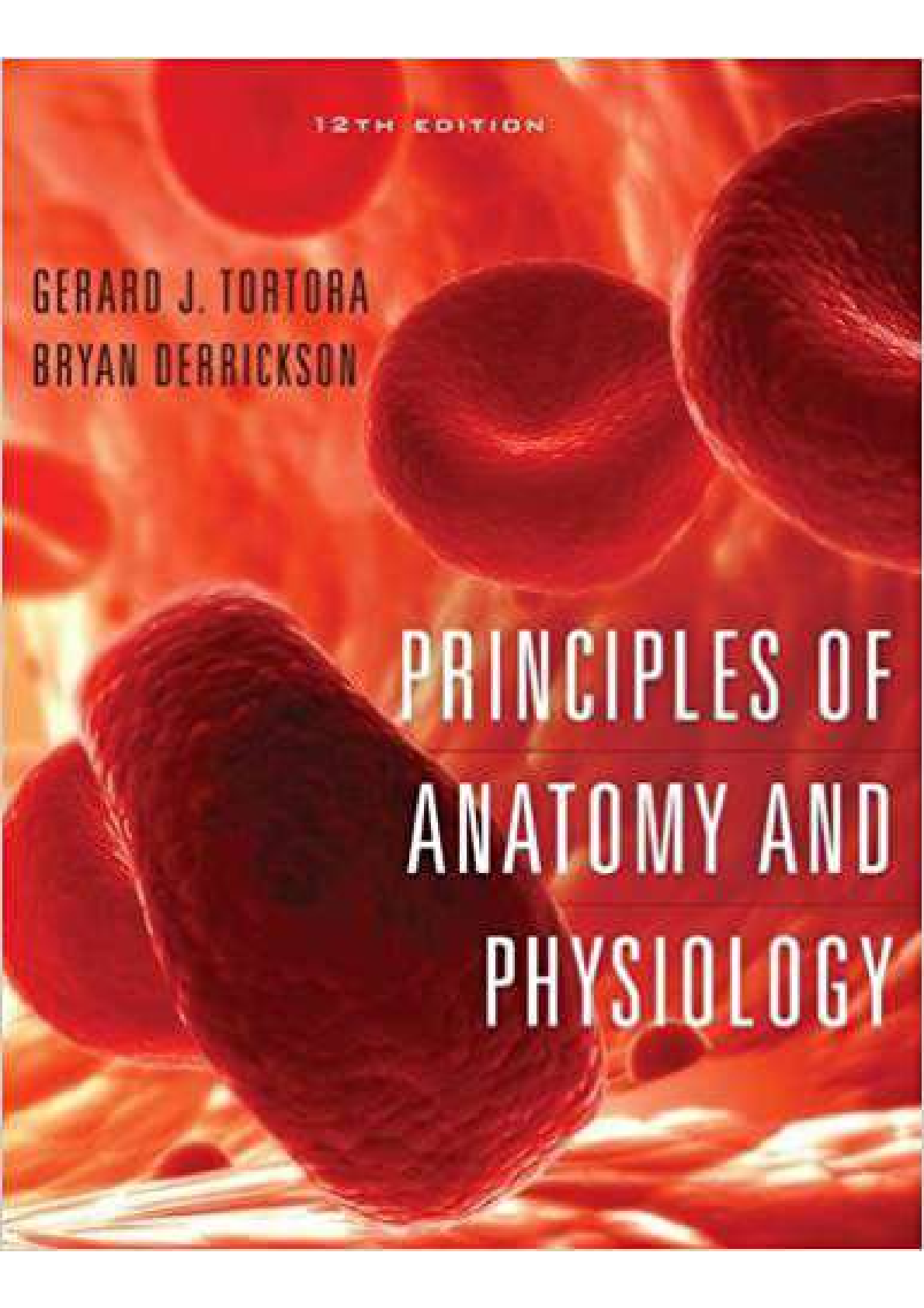*NURSING > TEST BANK > Chapter 29: Blood Vessels Patton: Anatomy and Physiology, 10th Edition 2022/2023 (All)
Chapter 29: Blood Vessels Patton: Anatomy and Physiology, 10th Edition 2022/2023
Document Content and Description Below
Chapter 29: Blood Vessels Patton: Anatomy and Physiology, 10th Edition 2022/2023 MULTIPLE CHOICE 1. Which of the following vessels do not have the ability to constrict and dilate? a. Arterioles b... . Arteries c. Capillaries d. Veins ANS: C DIF: Synthesis REF: p. 667 TOP: Structure of Blood Vessels 2. Both the tunica media and the tunica adventitia are absent in: a. arteries. b. veins. c. capillaries. d. both B and C. ANS: C DIF: Memorization REF: p. 668 TOP: Structure of Blood Vessels 3. The tissue layers of blood vessels from exterior to interior are: a. tunica media, tunica intima, and tunica adventitia. b. tunica adventitia, tunica media, and tunica intima. c. tunica intima, tunica media, and tunica adventitia. d. tunica media, tunica adveNnUtitRiaS, aInNd GtuTniBca.inCtOimMa. ANS: B DIF: Memorization REF: p. 668 TOP: Structure of Blood Vessels 4. Smooth muscle in blood vessels is located in the tunica: a. adventitia. b. intima. c. media. d. All of the above are correct. ANS: C DIF: Memorization REF: p. 668 TOP: Structure of Blood Vessels 5. Which of the following act as blood reservoirs? a. Arteries b. Arterioles c. Capillaries d. Veins ANS: D DIF: Memorization REF: p. 667 TOP: Veins 6. The structural components of the circulatory system include the: a. heart and lungs. Anatomy and Physiology 10th Edition Patton Test Bank NURSINGTB.COM N R I G B.C M b. heart and lymph nodes. c. heart and blood vessels. d. heart, vessels, and lymph nodes. ANS: C DIF: Memorization REF: p. 663 TOP: Introduction 7. In fetal circulation, the ductus arteriosus and foramen ovale: a. take blood from the fetus to the placenta. b. connect the pulmonary artery with the aorta. c. bypass the lungs. d. shunt blood from the right atrium into the left atrium. ANS: C DIF: Memorization REF: p. 688 TOP: Fetal Circulation 8. After birth the umbilical vessels remaining in the infant’s body: a. become fibrous cords that remain throughout life. b. are shed in about 6 weeks. c. shrink to eventually become capillaries. d. remain as possible shunts for use later in life. ANS: A DIF: Memorization REF: p. 689 TOP: Fetal Circulation 9. The order of blood flow through the vessels is: a. arterioles, venules, capillaries, arteries, and veins. b. arteries, arterioles, capillaries, venules, and veins. c. veins, venules, capillaries,UarteSrioleNs, aTnd arterOies. d. arterioles, arteries, capillaries, veins, and venules. ANS: B DIF: Memorization REF: pp. 664-667 TOP: Major Blood Vessels 10. Which of the following vessels carries blood from the lungs to the heart? a. Aorta b. Pulmonary artery c. Pulmonary vein d. Inferior vena cava ANS: C DIF: Memorization REF: p. 667 TOP: Major Blood Vessels 11. All arteries of the systemic circulation branch from the: a. superior vena cava. b. pulmonary artery. c. innominate artery. d. aorta. ANS: D DIF: Memorization REF: p. 668 TOP: Systemic Circulation 12. As the external iliac artery enters the thigh, its name changes to the artery. Anatomy and Physiology 10th Edition Patton Test Bank NURSINGTB.COM a. subclavian b. brachial c. femoral d. popliteal ANS: C DIF: Memorization REF: p. 671 TOP: Systemic Arteries 13. A vein that returns blood from the head is the: a. carotid. b. innominate. c. azygos. d. jugular. ANS: D DIF: Memorization REF: p. 682 TOP: Systemic Veins 14. Which of the following is a superficial vein in the lower arm? a. Great saphenous b. Cephalic c. Brachial d. Axillary ANS: C DIF: Memorization REF: p. 680 TOP: Systemic Veins 15. Blood from the stomach and intestines goes to the liver through the: a. hepatic portal vein. b. hepatic vein. c. renal vein. d. inferior vena cava. NURSINGTB.COM ANS: A DIF: Memorization REF: p. 683 TOP: Systemic Veins 16. Regarding fetal circulation, the small vessel connecting the pulmonary artery with the descending thoracic aorta is called the: a. ductus arteriosus. b. foramen ovale. c. ductus venosus. d. umbilical artery. ANS: A DIF: Memorization REF: p. 688 TOP: Fetal Circulation 17. In fetal circulation, the ductus venosus: a. takes blood from the fetus to the placenta. b. connects the pulmonary artery with the aorta. c. bypasses the liver. d. shunts blood from the right atrium into the left atrium. ANS: C DIF: Memorization REF: p. 688 TOP: Fetal Circulation Anatomy and Physiology 10th Edition Patton Test Bank NURSINGTB.COM 18. Atherosclerosis is characterized by the deposition of lipids in the tunica: a. intima. b. adventitia. c. media. d. All of the above are correct. ANS: A DIF: Memorization REF: p. 691 TOP: Mechanisms of Disease 19. Which of the following is a stretching of the artery walls? a. Varicose veins b. Anastomosis c. Phlebitis d. Aneurysm ANS: D DIF: Memorization REF: p. 691 TOP: Mechanisms of Disease 20. The pulmonary arteries carry blood to the: a. lungs. b. left atrium. c. right atrium. d. None of the above are correct. ANS: A DIF: Memorization REF: p. 669 TOP: Circulatory Routes 21. Which statement is true of arNteUrieRsS? INGTB.COM a. They always carry oxygenated blood. b. They always carry blood away from the heart. c. They are the capacitance vessels of the body. d. Both A and B are true of arteries. ANS: B DIF: Memorization REF: p. 664 TOP: Types of Blood Vessels 22. Which statement is true of veins? a. They always carry nonoxygenated blood. b. They can be either muscular or elastic. c. They always carry blood back to the heart. d. All of the above are true of veins. ANS: C DIF: Memorization REF: p. 667 TOP: Types of Blood Vessels 23. The most important blood vessels in the cardiovascular system are the: a. capillaries. b. arteries. c. veins. d. arterioles. ANS: A DIF: Memorization REF: p. 665 Anatomy and Physiology 10th Edition Patton Test Bank NURSINGTB.COM TOP: Capillaries 24. The blood vessel connecting the two capillary beds in the hepatic portal system is called a(n): a. artery, because it is carrying blood to a capillary bed. b. arteriole, because it has a precapillary sphincter muscle. c. vein, because it is draining blood from a capillary bed. d. portal vessel, because it is not easily classified as an artery or vein. ANS: C DIF: Application REF: p. 683 TOP: Systemic Veins 25. Which of these blood vessels are called resistance vessels? a. Venules b. Muscular arteries c. Arterioles d. Metarterioles ANS: C DIF: Memorization REF: p. 664 TOP: Arteries 26. Which of these blood vessels contain precapillary sphincters? a. Venules b. Muscular arteries c. Arterioles d. Metarterioles ANS: D DIF: Memorization REF: p. 664 TOP: Arteries 27. After birth the ductus venosuNsUclRosSesIaNndG:TB.COM a. allows blood to flow to the lungs. b. allows blood to flow to the liver. c. prevents blood from moving from the right to the left atrium. d. stops blood flow to the placenta. ANS: B DIF: Application REF: p. 688 TOP: Fetal Circulation 28. Christopher, a 2-month-old infant, has a bluish tinge to his skin. Upon listening to the infant’s chest, the physician became concerned about a leakage of blood between the right and left atria. What might have caused this problem and what is the treatment? a. The ductus venosus may not have closed at birth, and immediate surgical repair may be needed. b. The ductus arteriosus may not have closed at birth, and immediate surgical repair may be needed. c. The foramen ovale may not be closed, causing backflow of blood into the lungs. The physician will reexamine the infant frequently because the foramen ovale may take as long as 9 months to heal. d. The foramen ovale may be closed, causing backflow of blood into the lungs. The physician will reexamine the infant frequently because the foramen ovale may take as long as 9 months to open. ANS: C DIF: Application REF: p. 689 TOP: Changes in Circulation at Birth Anatomy and Physiology 10th Edition Patton Test Bank NURSINGTB.COM TRUE/FALSE 1. The tunica media is also called the tunica adventitia. ANS: F DIF: Memorization REF: p. 668 TOP: Layers of the Blood Vessel Wall 2. Arteries always carry blood away from the heart. ANS: T DIF: Memorization REF: p. 664 TOP: Types of Blood Vessels 3. The tunica intima of arteries provides a smooth lining with valves to ensure one-way flow. ANS: T DIF: Memorization REF: p. 668 TOP: Layers of the Blood Vessel Wall 4. Veins always carry deoxygenated blood. ANS: F DIF: Memorization REF: p. 667 TOP: Types of Blood Vessels 5. As the external iliac artery enters the thigh, its name changes to the femoral artery. ANS: T DIF: Memorization REF: p. 671 TOP: Systemic Arteries NURSINGTB.COM 6. Precapillary sphincters increase the flow of blood through a tissue when they relax. ANS: T DIF: Memorization REF: p. 664 TOP: Arteries 7. Precapillary sphincters are located in venules. ANS: F DIF: Memorization REF: p. 664 TOP: Arteries 8. Pulmonary circulation is blood flow through the liver. ANS: F DIF: Memorization REF: p. 669 TOP: Circulatory Routes 9. Systemic circulation includes blood flow to all parts of the body except the lungs. ANS: T DIF: Memorization REF: p. 669 TOP: Circulatory Routes 10. The pulmonary artery carries oxygenated blood. ANS: F DIF: Memorization REF: p. 668 TOP: Circulatory Routes Anatomy and Physiology 10th Edition Patton Test Bank NURSINGTB.COM 11. The circle of Willis is an example of an anastomosis. ANS: T DIF: Memorization REF: p. 673 TOP: Systemic Arteries 12. The ductus arteriosus allows fetal blood to bypass the nonfunctioning fetal liver. ANS: F DIF: Memorization REF: p. 688 TOP: Fetal Circulation 13. Umbilical arteries carry blood from the placenta to the fetus. ANS: F DIF: Memorization REF: p. 686 TOP: Fetal Circulation 14. There are two umbilical arteries and one umbilical vein. ANS: T DIF: Memorization REF: p. 686 | p. 688 TOP: Fetal Circulation 15. A stenotic valve is a leaky valve. ANS: F DIF: Memorization REF: p. 691 TOP: Mechanisms of Disease 16. One function of elastic fibers is to help maintain blood pressure. ANS: T DIF: M N emUo R riSza ItioNn GT B.CO M TOP: Elastic Fibers 17. Arteriosclerosis means “chest pain.” REF: p. 667 ANS: F DIF: Memorization REF: p. 690 TOP: Mechanisms of Disease 18. Blood flow from the pulmonary arteries leads to the lungs. ANS: T DIF: Memorization REF: p. 669 TOP: Circulatory Routes 19. The descending aorta is composed of the thoracic and abdominal aortas. ANS: T DIF: Memorization REF: p. 671 TOP: Systemic Arteries 20. Smooth muscle is found in all parts of the vascular system except the capillaries. ANS: T DIF: Memorization REF: p. 667 TOP: Structure of Blood Vessels 21. The tunica media in veins is thinner than the tunica media in arteries. Anatomy and Physiology 10th Edition Patton Test Bank NURSINGTB.COM ANS: T DIF: Memorization REF: p. 668 TOP: Structure of Blood Vessels 22. Very large arteries are called sinuses. ANS: F DIF: Memorization REF: p. 679 TOP: Types of Blood Vessels 23. The blood vessels that supply other blood vessels with blood are called the vasa vasorum. ANS: T DIF: Memorization REF: p. 668 TOP: Structure of Blood Vessels 24. Microcirculation includes only the blood flowing through the capillaries. ANS: F DIF: Memorization REF: p. 664 TOP: Capillaries 25. Capacitance is a characteristic of veins. ANS: T DIF: Memorization REF: p. 667 TOP: Veins 26. All blood returns to the heart by way of either the superior vena cava or the inferior vena cava. ANS: F DIF: Application REF: pp. 668-669 TOP: Circulatory Routes 27. The first part of the aorta is cN alleR d thI e aoG rticB a. rcC h. M U S N T O ANS: F DIF: Memorization REF: p. 673 TOP: Systemic Arteries 28. Veins tend to have more anastomoses than do arteries. ANS: T DIF: Memorization REF: p. 679 TOP: Systemic Veins 29. A portal system sends blood through two sets of capillaries. ANS: T DIF: Memorization REF: p. 669 TOP: Systemic Veins 30. It is easier for material to pass through a continuous capillary than through a fenestrated capillary. ANS: F DIF: Memorization REF: p. 666 TOP: Capillaries 31. Continuous, fenestrated, and sinusoid are all terms that can describe a type of capillary. ANS: T DIF: Memorization REF: pp. 665-666 TOP: Capillaries CONTINUES... [Show More]
Last updated: 1 year ago
Preview 1 out of 87 pages

Reviews( 0 )
Document information
Connected school, study & course
About the document
Uploaded On
Sep 29, 2022
Number of pages
87
Written in
Additional information
This document has been written for:
Uploaded
Sep 29, 2022
Downloads
0
Views
34

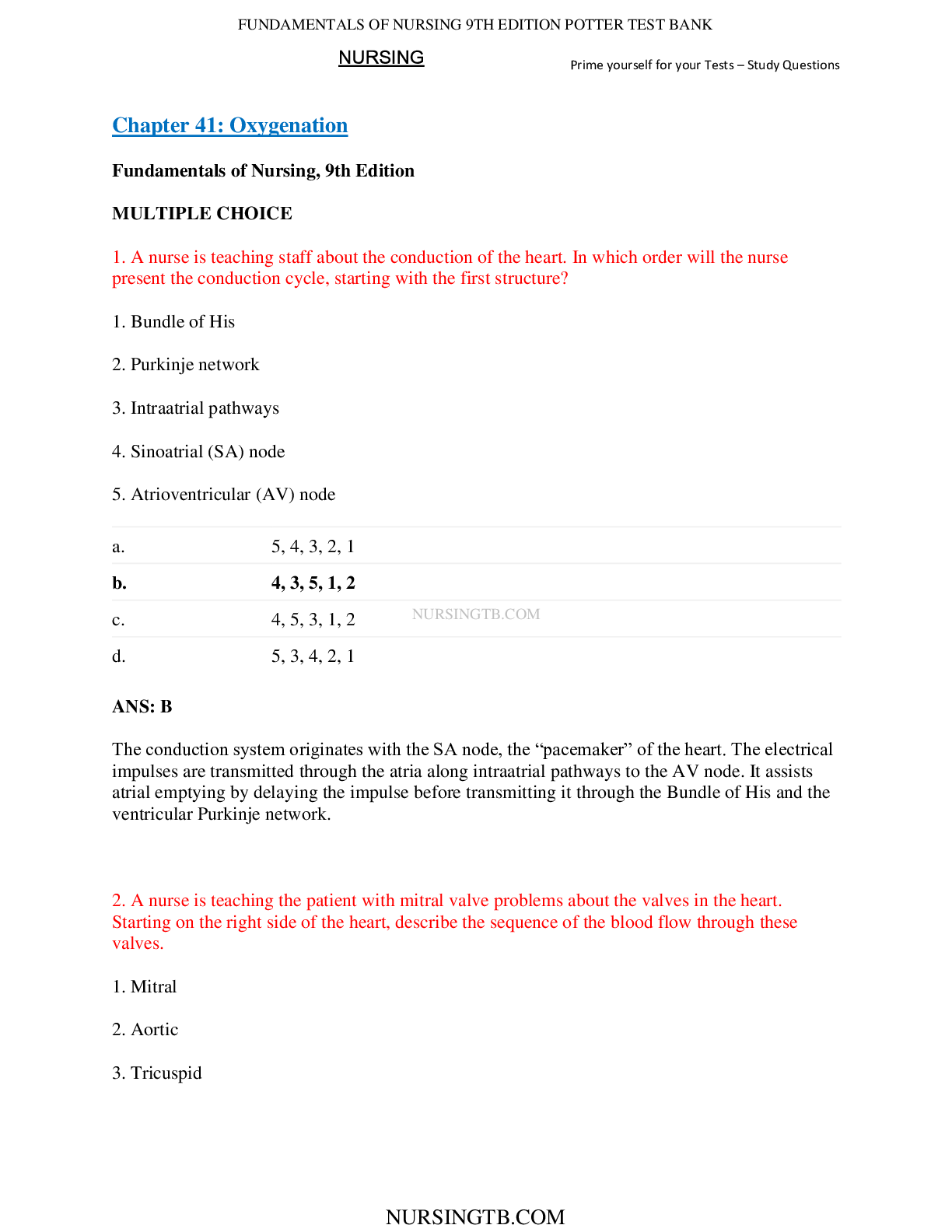




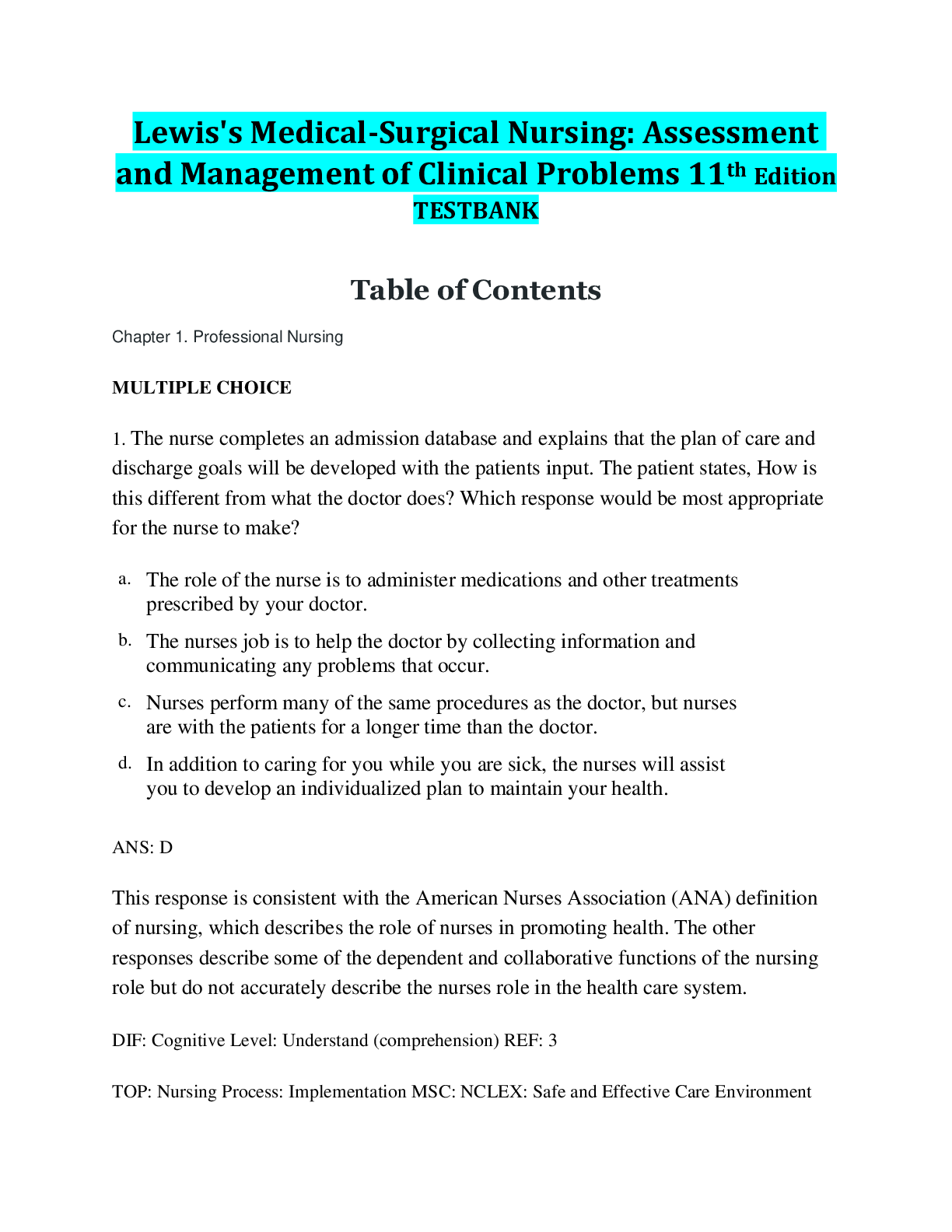
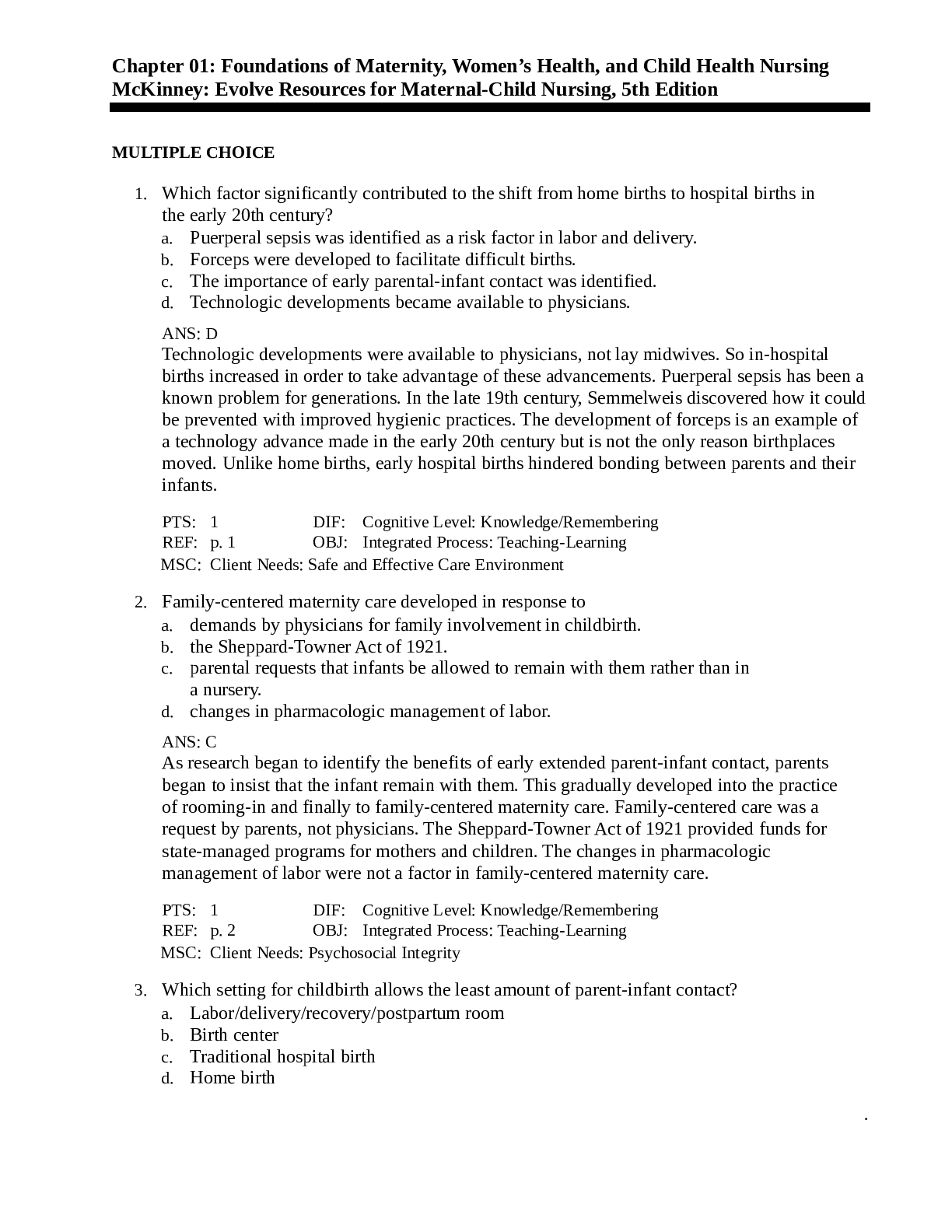
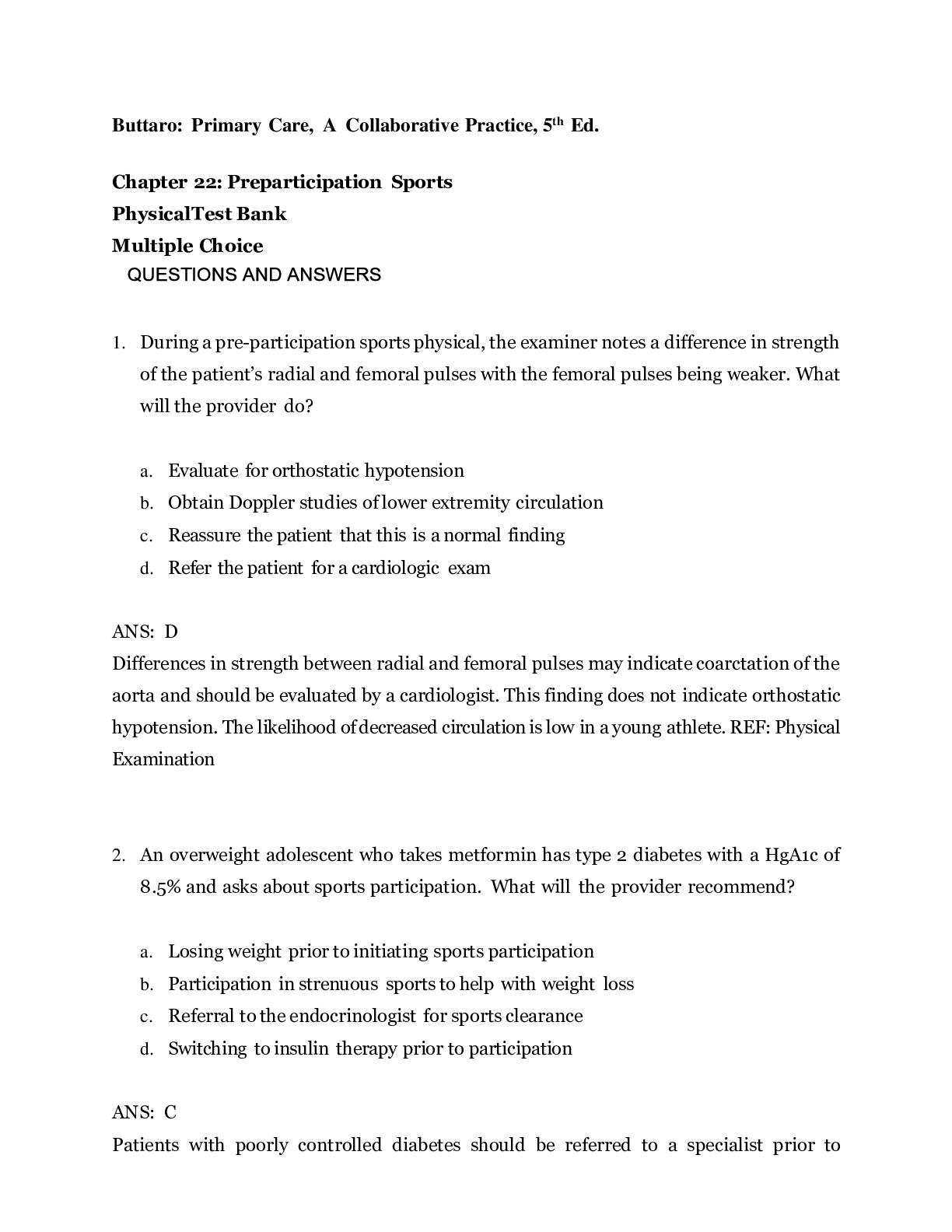


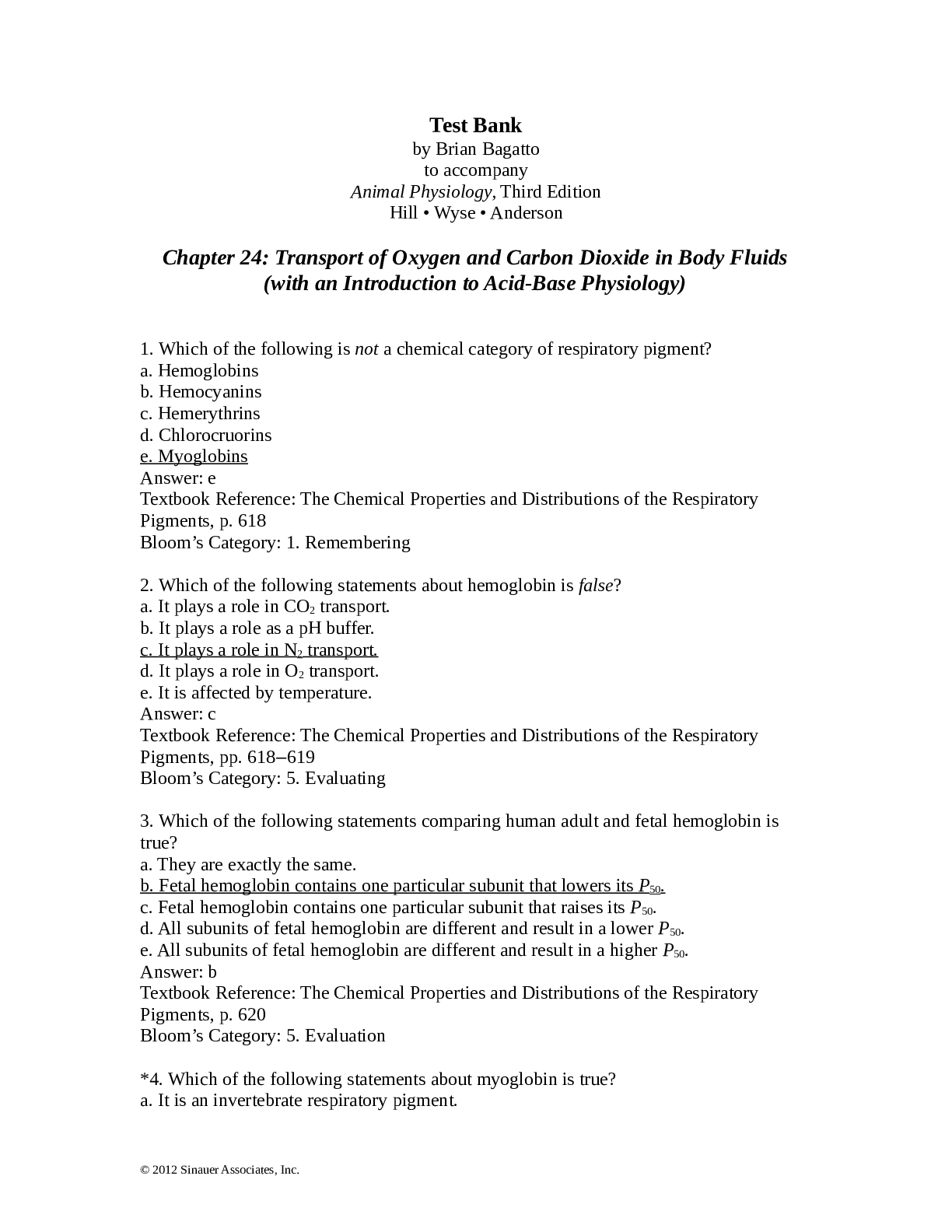
.png)
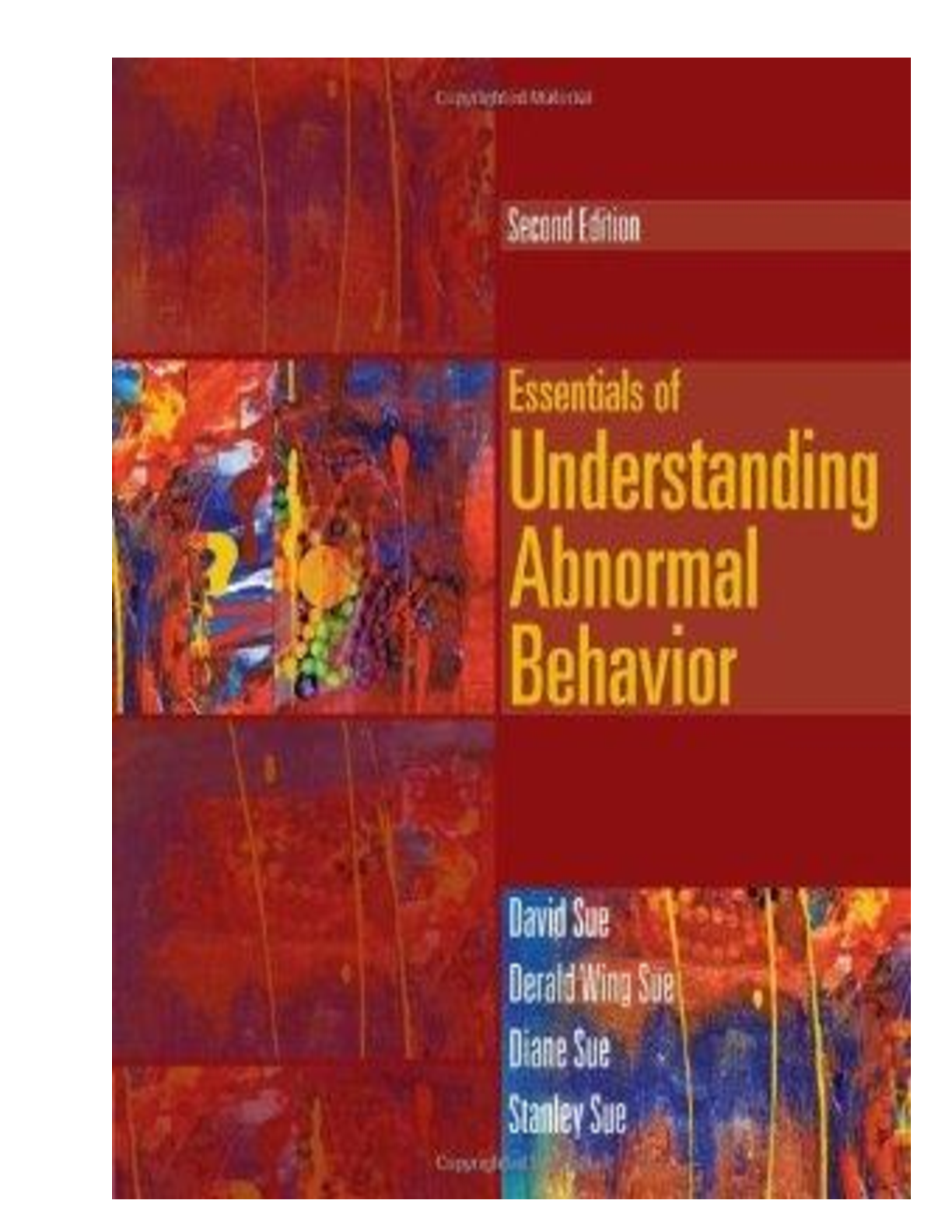


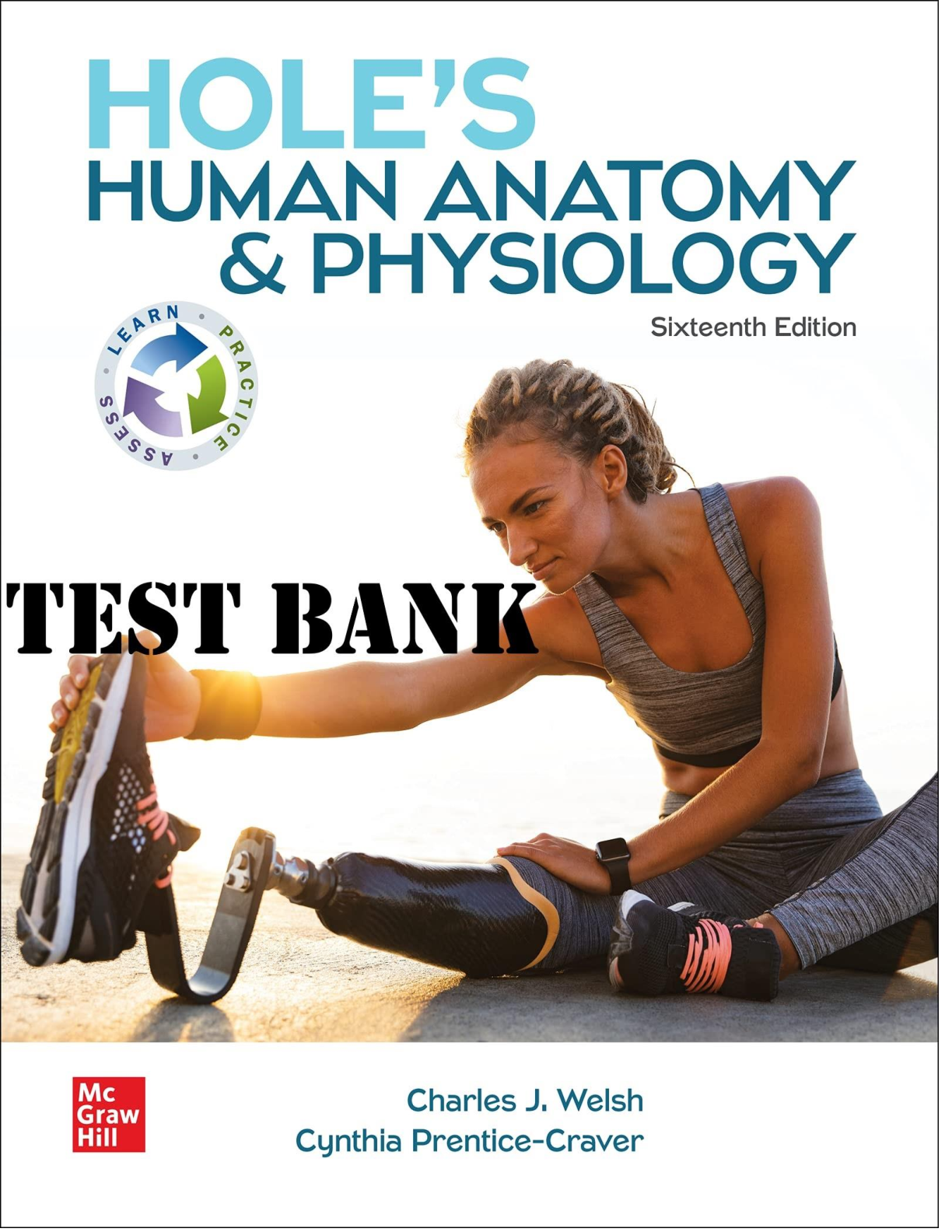
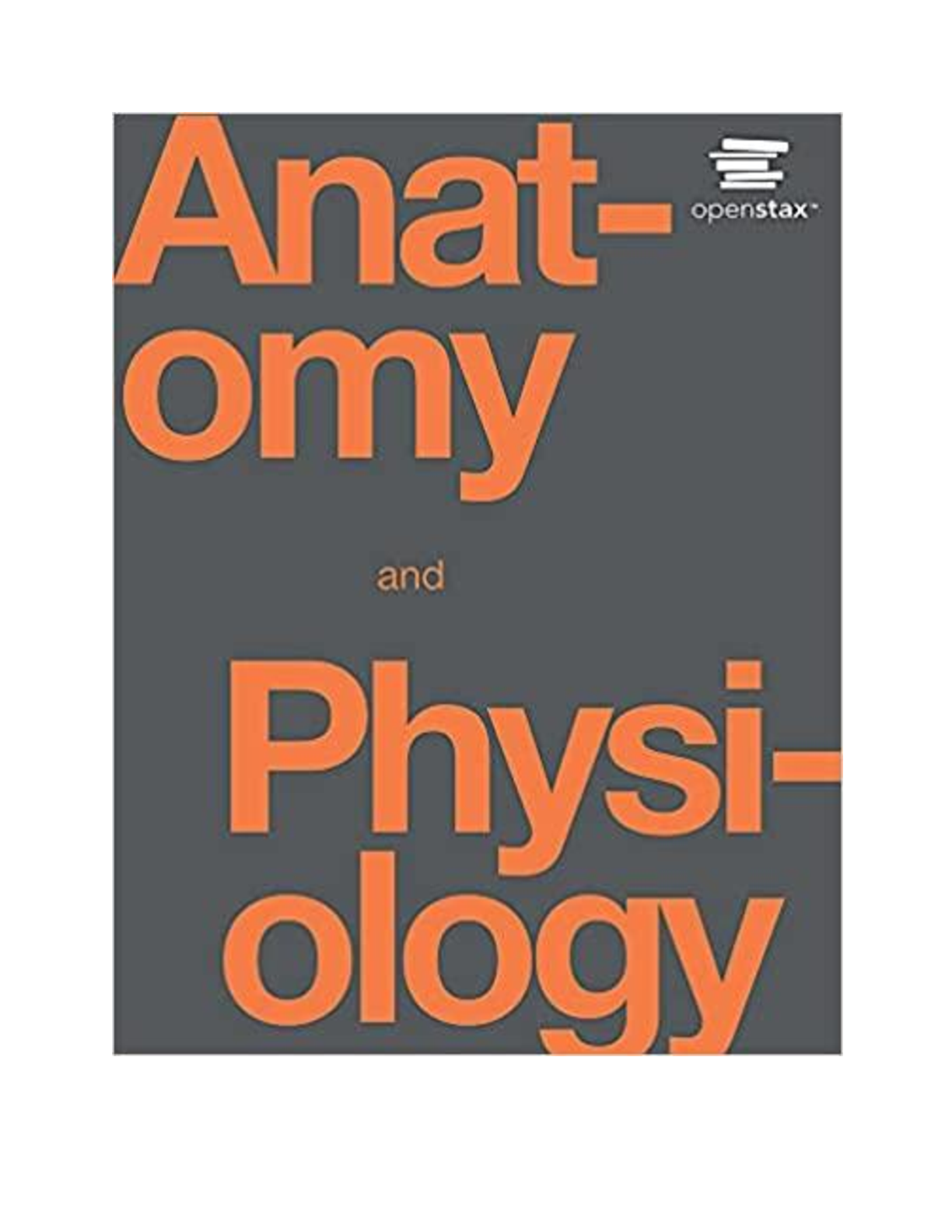
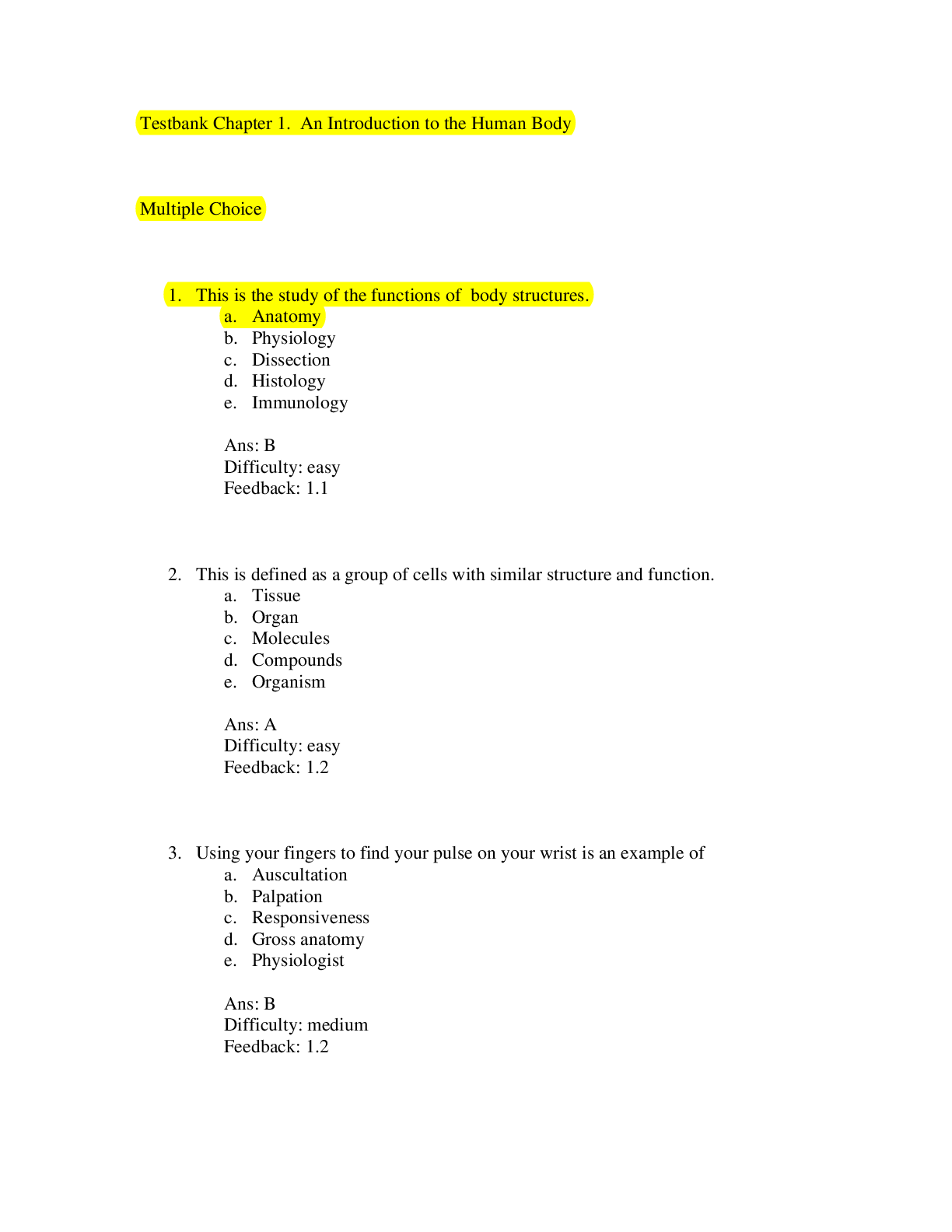
.png)


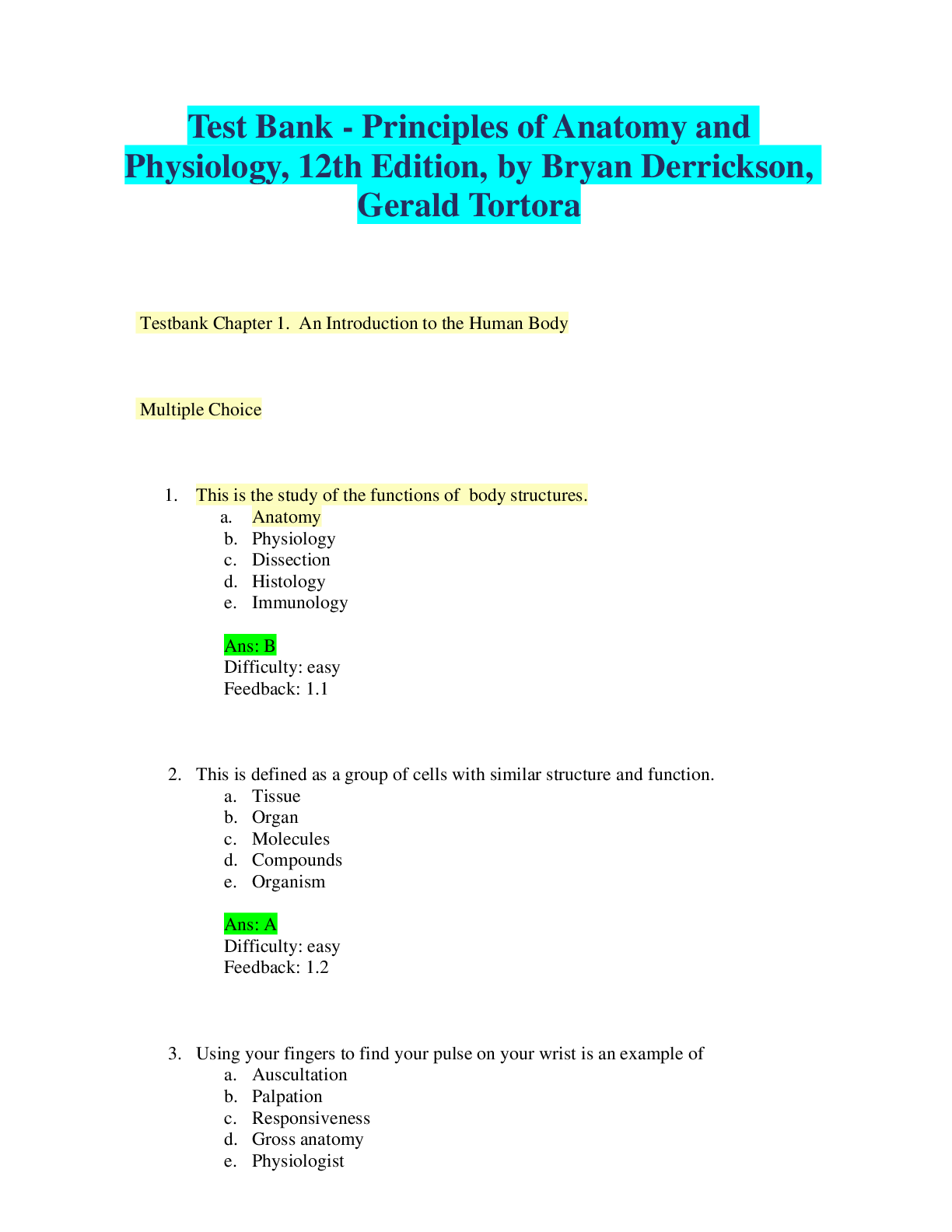



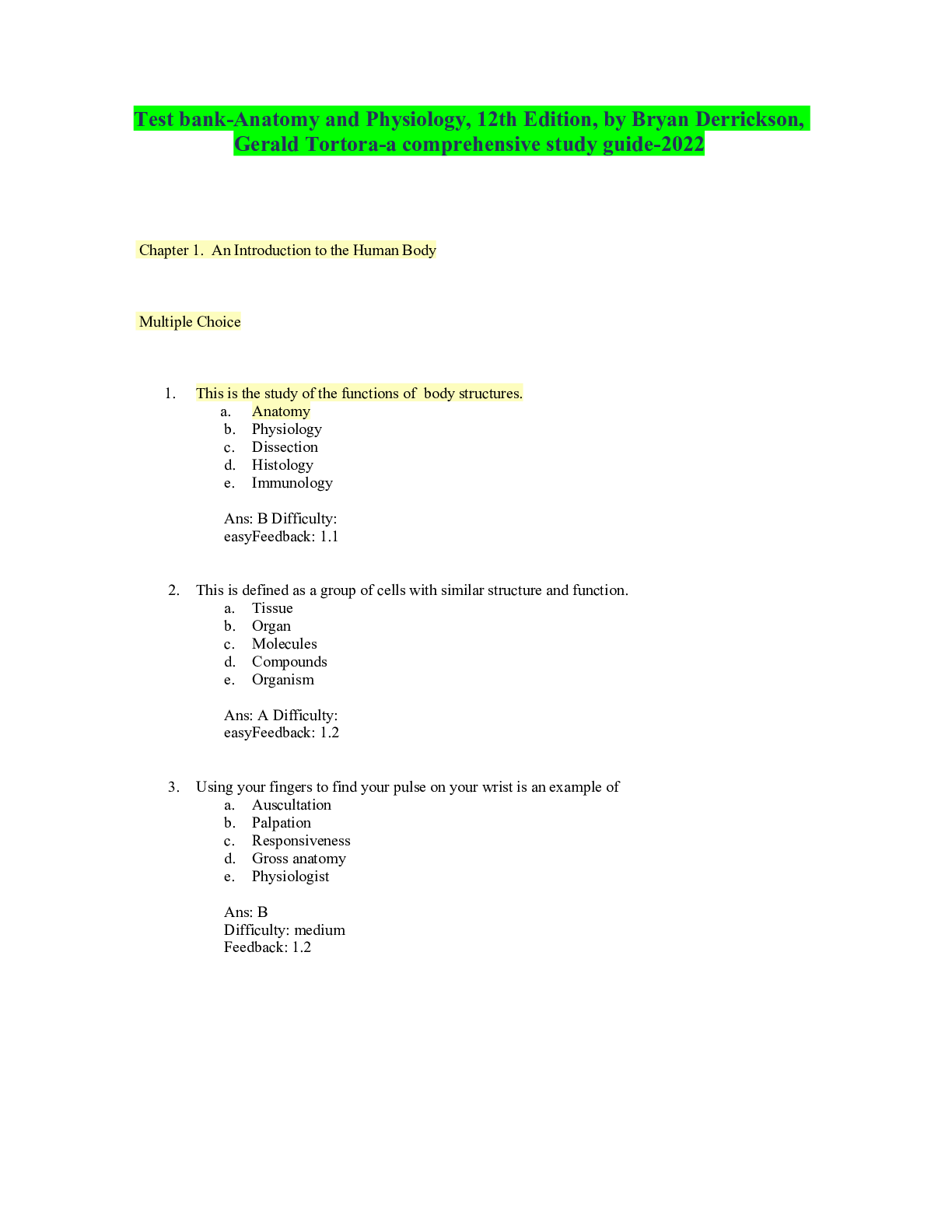
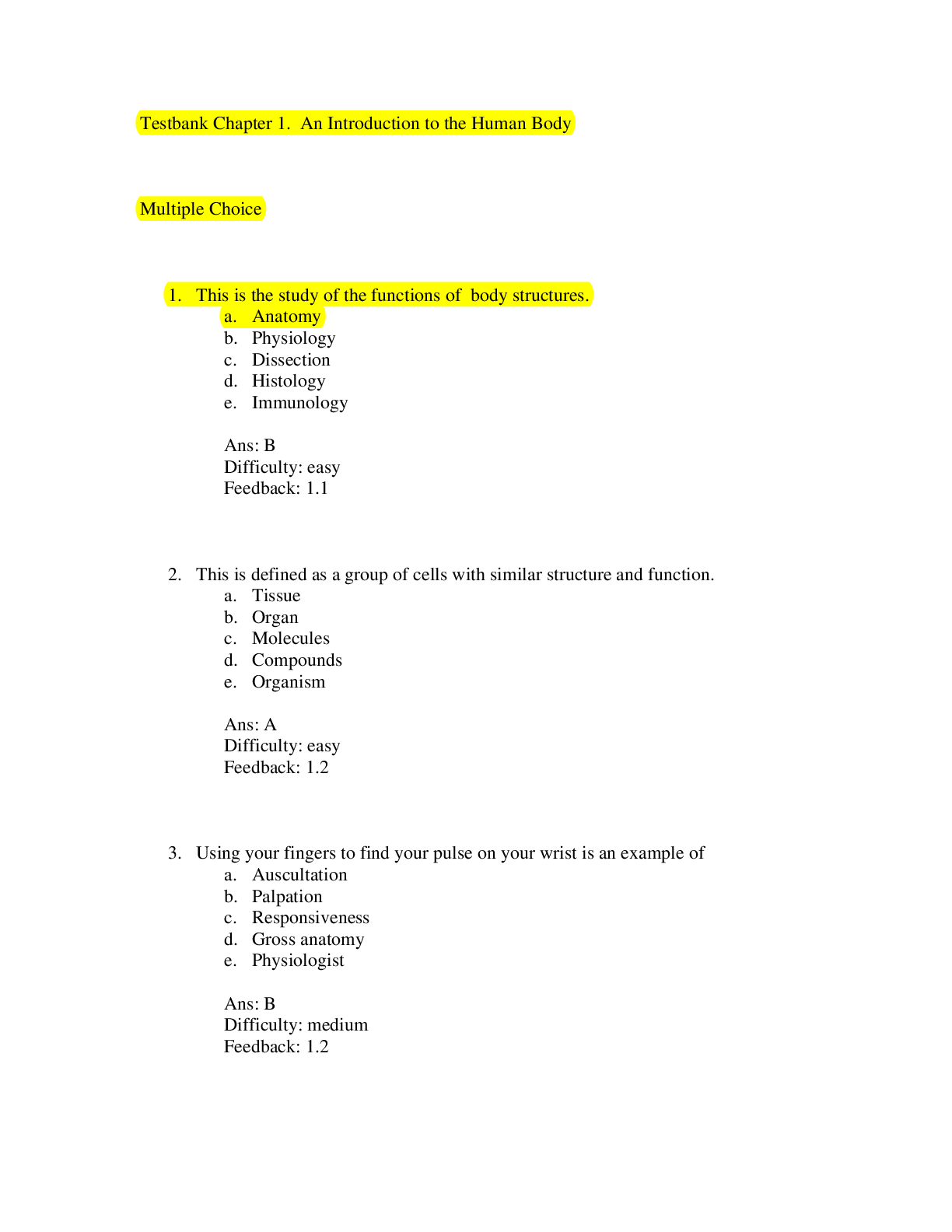
.png)

